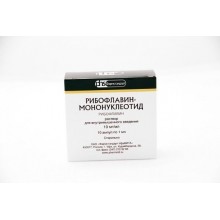



Vitamin B2. Regulating redox processes, it participates in protein, fat and carbohydrate metabolism, as well as in maintaining the normal visual function of the eye and the synthesis of hemoglobin.
Pharmacokinetics
Riboflavin and its nucleotides are rapidly absorbed from the gastrointestinal tract. Chronic gastritis, enteritis, ahilia slow absorption. It is unevenly distributed in the organs and tissues of the body: the largest number is in the myocardium, liver, and kidneys. Plasma protein binding - 60%. Gets through a placental barrier, it is allocated with breast milk. Excreted by the kidneys.
Hypo-and beriberi B2, hemeralopia, conjunctivitis, keratitis, iritis, corneal ulcer, cataract, nonhealing wounds and ulcers, common eating disorders, radiation sickness, asthenia, bowel dysfunction, hepatitis
Active ingredient: Riboflavin (in the form of a mononucleotide) 10 mg;
No customer reviews for the moment.
Single dose - 5-10 mg, for children - 2-5 mg 1-3 for 1-1.5 months.
Possible: allergic reactions, impaired renal function, impaired vision
Hypersensitivity to riboflavin, nephrolithiasis.
With simultaneous use with m-holinoblokatorami increases the absorption and bioavailability of riboflavin (by reducing intestinal motility).
With simultaneous use with thyroid hormones, riboflavin metabolism accelerates.
With simultaneous use decreases the activity of doxycycline, tetracycline, oxytetracycline, erythromycin and lincomycin.
Riboflavin is incompatible with streptomycin.
With simultaneous use, side effects of chloramphenicol are reduced and prevented (hematopoietic dysfunction, optic neuritis).
With the simultaneous use of chlorpromazine, amitriptyline due to the blockade of flavinokinase violate the inclusion of riboflavin in flavivadine mononucleotide and flavin adenine dinucleotide and increase its excretion with urine.
Perhaps the use of riboflavin during pregnancy and lactation (breastfeeding) according to indications
It paints urine in a light yellow color.